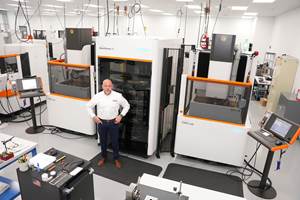Adopting Automation
Shops are facing increased demand for shorter lead times, improved quality and lower costs. Automation offers several key advantages for overcoming these challenges.
Advancements in automated technologies have expanded to accommodate high-mix production demands, and these technologies are ideal for mold, tool and die machining processes. Complex and sophisticated material-handling cells can be designed for a wide variety of applications, including hard milling, graphite milling, five-axis machining, and sinker and wire EDM. The net result is consistent performance and improved efficiencies across all processes through the elimination of manual setups and stack-up error. Also, automation of mold, tool and die processes support companies in optimizing labor resources by removing non-value-added labor practices and empowering companies to redeploy labor into more value-added roles that focus on business growth.
Many mold, tool and die shops are facing increased demand for shorter lead times, improved quality and lower costs. Automation offers several key advantages for overcoming these challenges:
Lead time reduction. Implementing automation can provide dramatic reductions in lead times, as well as improved flexibility in production schedules. By decoupling setup processes from machining processes, automation can maximize machine utilization, from an average of 30 to 35 percent on stand-alone machines to as much as 85 percent within an automated cell. It also can enable shops to accommodate quick turnaround in completing urgent engineering changes without disrupting processes in progress. This flexibility is ideal for mold, tool and die shops that need to shift rapidly within a high-product-mix environment. Moreover, the ability to perform lights-out processing opens up additional machining time to produce more workpieces during off hours, particularly long-cycle-time applications.
Shorter lead times and improved scheduling flexibility also can provide greater throughput and opportunities to improve workflow efficiency and reduce on-hand inventory.
Quality improvement. By automating work loading/unloading and reducing the number of setups for processing, shops that use automation can benefit from greater accuracy, quality and consistency, because this capability eliminates several of the most common sources for deviation, including human error and stack-up error. Additionally, many automated systems are designed with in-process error-prevention technologies such as coordinate measuring, tool-length measurement, and fixture, workpiece or tool probing. When engineered properly, closed-loop feedback can be also introduced into a cell for even higher degrees of quality and confidence.
Cost reduction. Automation can be one of the most powerful means for reducing the cost of producing molds, tools and dies. With fewer setups, elimination of manual loading and unloading, less secondary handwork and the ability for one operator to manage multiple machines simultaneously, automated machining systems can enable shops to significantly reduce non-value-added labor time and its associated costs. They also can relieve stress and costs associated with identifying the additional skilled labor resources necessary to grow capacity.
Cost reductions also can be realized with faster return on investment in capital equipment and the ability to extend operating hours through unattended operation.
Making the move to automation should not be taken lightly, however. Designing, engineering and implementing an automated machining cell is a complex process that should be performed with the support of experienced engineering partners and equipment providers. This buy-in is essential to ensure the effectiveness and long-term reliability of any investment in automation.
Related Content
Mold Builder Meets Increased Domestic Demand With Automated Cells
Burteck LLC experienced significant demand increases due to reshoring and invested in automated machining cells to step up its production output quickly and avoid losing business.
Read MoreMMT Chats: Eliminating the Noise to Stay Focused on the Customer
Metro Mold & Design joins me to discuss the value of the 80/20 rule as a business strategy, its talented cross-functional team, the role of automation in mold building and molding, and the continuing impact of COVID-19.
Read MoreQuality Tool & Die Enhances Performance With Advanced EDM and Milling Technologies
The adoption of Mitsubishi wire and sinker EDMs, along with the OPS Ingersoll five-axis milling machine with automated cells, has enabled unmanned operations and improved precision. As a result, QTD has expanded its facility, grown its workforce and increased its business by 10-15% annually.
Read More2024 Moldmaking Insights: A Year in Review Part 1
A look back at the top moldmaking trends of 2024, as revealed through MMT's analytics. This review highlights the most popular technical articles, case studies, tips and best practices that captured the industry's attention over the past year.
Read MoreRead Next
How to Use Strategic Planning Tools, Data to Manage the Human Side of Business
Q&A with Marion Wells, MMT EAB member and founder of Human Asset Management.
Read MoreReasons to Use Fiber Lasers for Mold Cleaning
Fiber lasers offer a simplicity, speed, control and portability, minimizing mold cleaning risks.
Read MoreAre You a Moldmaker Considering 3D Printing? Consider the 3D Printing Workshop at NPE2024
Presentations will cover 3D printing for mold tooling, material innovation, product development, bridge production and full-scale, high-volume additive manufacturing.
Read More




















